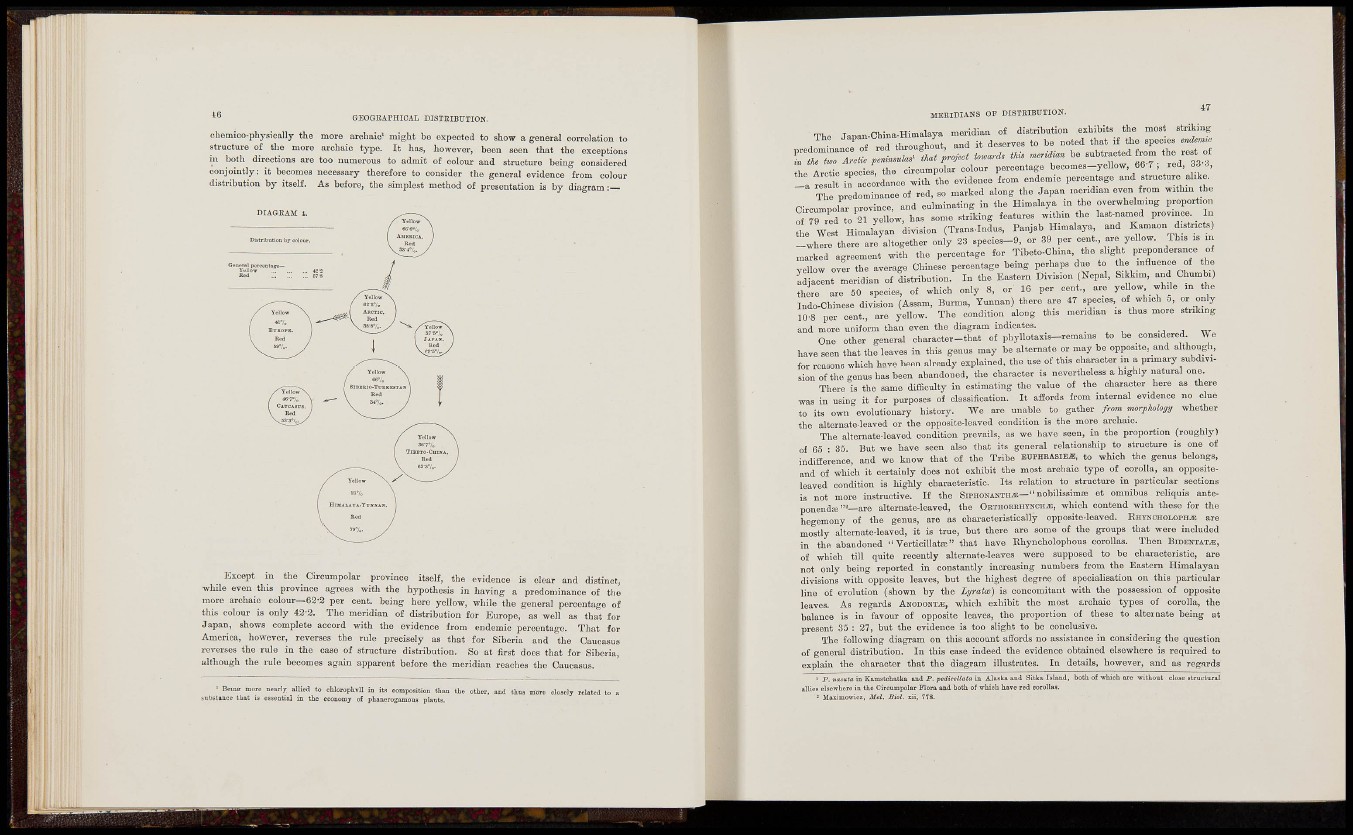
GEOGEAPHICAi DISTIilBITTION.
chomioo-physically the more archaic' might be expected to show a general correlation to
structure of the more archaic type. It has, howcrer, been seen that the exceptions
in both directions are too numerous to admit of colour and structure being considered
c o n j o i n t l y : it becomes necessary therefore to consider the general evidence from colour
distribution by itself. As before, the simplest method of presentation is by diagram
Except in the Circumpolar proTÍnce itself, the evidence is dear and distinct,
while even this province agrees with the hypothesis in having a predominance of the
more archaic colour—62-3 per cent, being here yellow, while the general percentage of
t h i s colour is only 42-2. The meridian of distribution for Europe, as well as that for
J a p a n , shows complete accord with the evidence from endemic percentage. That for
America, however, reverses the rule precisely as that for Siberia and the Caucasus
reverses the rule in the case of structure distribution. So at first does that for Siberia,
although the rule becomes again apparent before the meridian rcaches the Caucasus.
' Bemc more nearly allied to cMoropliTll in its composition than tlie otlior, and tlins more ciosclj related to s
snbstance tliat is essential in the economy of plianerogamous plants.
MEEIDIANS OF DISTEIBTIIIOH.
The Japan-China-Hlmalaya meridian of distribution exhibits the most striking
The it asserves to be noted that ii the species eniemw
the Arctic species, the circampolar colour percentage becomes-ycllow, 66 7 ; red, 33 d,
a tes ! accordance with the evidence from endemic percentage and structure alike.
The predominance of red, so marked along the Japan meridian even from within the
Circumpolar province, and culminating in the Himalaya in the overwhelming proportion
S T r e d to 2X yellow, has some striking features within the last-named province^ n
h e West Himalayan division (Trans-Indns, Panjab Himalaya, and Kamaon istrrcts,
- w h J r e there are altogether only 23 .pecies-9, or 39 per cent., are yellow. This is iii
marked agreement with the percentage for Tibeto-China, the slight preponderance of
yellow over the average Chinese percentage being perhaps due to f
I d i a c e n t meridian of distribution. In the Eastern Division (Nepal, Sikkim, and Chumbi)
t h L are 50 species, of which only 8, or 16 per cent., are yellow while in the
Indo-Chinese division (Assam, Burma, Yunnan) there are 47 species, of which 6, or only
10-8 per cent., are yellow. The condition along this meridian is thus more strrkmg
and more unifomi than even the diagram indicates. .. , w
One other general elmracter-that of phyllotaxis-remains to be considered. We
have seen that the leaves in this genus may be alternate or may be opposite, and although,
for reasons which have been already explained, the use of this character m a primary subdivision
of the genus has been abandoned, the character is nevertheless a highly natural one.
Thero is the same difficulty in estimating the value of the character here as there
was in using it for purposes of classification. It affords from internal evidence no clue
to its own evolutionary history. We are unable to gather from rmrfUhgy whether
t h e alternate-leaved or the opposite-leaved condition is the more archaic.
The alternate-leaved condition prevails, as we have seen, in the proportion (roughly)
of 65 • 35. But we have seen also that its general relationship to structure is one of
indiflerence, and we know that of the Tribe EUPHEASIEJ:, to which the genus belongs,
and of which it certainly does not esliibit the most archaic type of corolla, an oppositeleaved
condition is highly characteristic. Its relation to structure in particular sections
is not more instructive. If the SipHOUiHTHiE—"nobilissima! et omnibus rehquis anteponendas"'—
are alternate-leaved, the OaTnOEKHYSCHiE, which contend with these for the
hegemony of the genus, are as chai-acteristioally opposite-leaved. EHYKOHOLOPHJE are
mostly alternate-leaved, it is true, but there are some of the groups that were included
in the abandoned Verticillataî" that have Khyncholophous corollas. Then BIDENTATJ!,
of which till quite recently alternate-leaves were supposed to be characteristic, are
not only being reported in constantly increasing numbers from the Eastern Himalayan
divisions with opposite leaves, but the highest degree of specialisation on this particular
line of evolution (shown by the Lyratoe) is concomitant with the possession of opposite
leaves. As regards AHODOHTJÎ, which exhibit the most archaic types of corolla, the
balance is in favom- of opposite leaves, the proportion of these to alternate being at
present 35 ; 27, but the evidence is too slight to be conclusive.
The following diagram on this account affords no assistance in considering the question
of general distribution. In this case indeed the evidence obtained elsewhere is required to
explain the character that the diagram illustrates. In details, however, and as regards
' p. «asiiia in Kamstcliatka a^A P. peiUeUatam Alaska aud Sitka Island, botb of wliioll are withont close structural
allies elsewUore in the Circumpolar Flora and both of which have red eorolias.
= MaïimowLcc, Met. Biol, lii, 778.